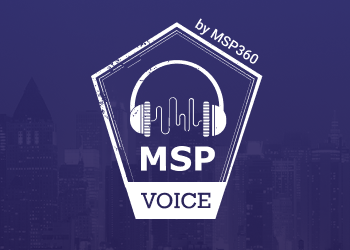We are happy to introduce MSP360 Backup for Microsoft 365 and Google Workspace 4.8, which brings a major addition to the storage experience – built-in managed cloud storage.
With this release, the need for third-party storage setup is entirely eliminated, configuration time is reduced, and administrators can start protecting Microsoft 365 and Google Workspace data immediately upon sign up. Continue reading
How Ransomware Works and How Backups Can Help
If you think ransomware works in the same way as other types of cyberattacks, you may be overlooking important steps for protecting against it. This article provides an overview of defending yourself against ransomware by assessing the current state of ransomware threats and discussing the latest developments in ransomware design, and creating a ransomware backup strategy.
Continue reading
PowerShell Remote Alerts for Firewall
December 2019 has witnessed three major ransomware attacks on MSPs and service providers (and we're only halfway through the month!). The data of more than 100 dentistry practices was encrypted via an attack on an MSP, one of the biggest US data centers provider was hit and the data of several non profit organizations was encrypted with ransom demands of around $500,000.
What Dark Web Monitoring Means for MSPs
The dark web doesn’t have to be a foreign concept to your clients. Look at it as an opportunity to provide additional value to them through your own dark web monitoring services. Unlike other services MSPs provide, dark web monitoring is still in its infancy, so differentiate your offering today. Continue reading
MSP Voice Episode 70 – “Pricing and Packaging” with Nigel Moore
This week my guest is Nigel Moore with The Tech Tribe who joins us from Australia. Having been in the business since 2002, Nigel has an interesting story about how he came to own his own MSP in 2007. Continue reading
Data Backup Security Considerations for MSPs
Managing one server can be complicated enough, but what if you have multiple platforms to protect? Multi-server platforms are more common as we transition to an environment of highly distributed, cloud-based platforms. As we move further, multi-tenancy is becoming the new black when it comes to digital ecosystems. Continue reading
MSP Voice Episode 69 – “Self Made” with Andrew Lassise
Andrew started off with a degree in finance in 2009. Unfortunately, because of the recession, he had to switch gears and focus on IT instead of finance. He found a position at a company doing break-fix remotely and then was approached by some friends about starting their own IT company. Continue reading
MSSP Is a Hard Nut. Think About the Alliance
According to the 2019 Cost of Cybercrime Study report by Accenture & Ponemon, the world economy is at risk of losing $US5.2 trillion globally over the next five years to cyber attacks. To avoid becoming a statistic in today’s dangerous cybersecurity landscape, more and more businesses are seeking ways to improve their security posture. Continue reading
AYCE Is a No Go For an Advanced Security Offering
For MSPs, pricing can mean the difference between signing on a new client or having potential leads check out the competition. Even when your service offerings are amazing, customers may pass due to pricing (that seems too low or too high). Continue reading
MSP Voice Episode 68 – “Clients, not Customers” with Thomas O’Brien
This week I welcome Thomas O’Brien with IDEOLITY to the show. Thomas is in the Kansas City area and has been in business since 1988. While it took Thomas and his partners about 3 years to settle on IT services, they have been going strong ever since. In 2008 they changed the name of the company to IDEOLITY to better reflect what they do and it’s also much shorter than the previous name. Continue reading
Connect (Formerly Remote Desktop) for MacOS 1.0 is Out
MSP360™ Connect (Formerly Remote Desktop) for macOS is a tool that enables quick and secure connections to remote systems, making it easy for MSPs to provide support over the internet.
How You Can Transition Your Break-Fix Clients to Managed Services
All successful MSP business models are built on recurring revenue streams. When starting out, most MSPs typically have a large number of break-fix customers. This means they only make money when their client has an IT problem and something needs fixing. Continue reading














